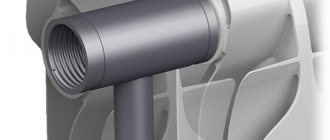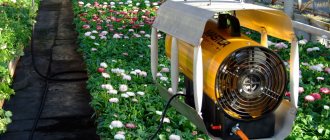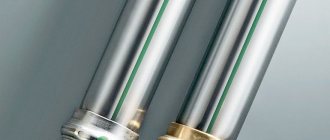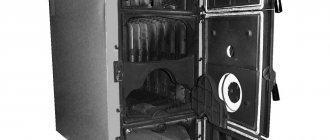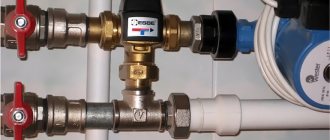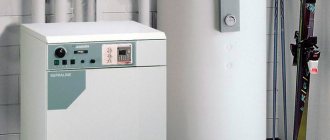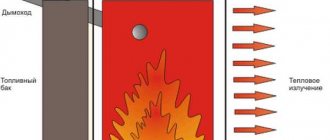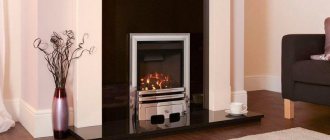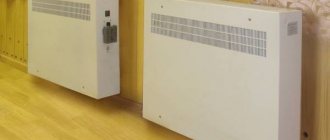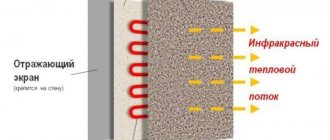SavingSavingDelete 4
- What to look for when choosing a radiator for your home
- The best manufacturers of heating radiators
- The best bimetallic radiators
- The best aluminum heating radiators
- The best steel heating radiators
- The best cast iron heating radiators
- Let's compare the models
- Which radiator is better to choose?
Heating radiators are special devices for heating rooms. They consist of several separate, special elements. Models produced today differ in the materials from which they are made, as well as in design, heat accumulation, type of thermal fluid, the presence of additional functions and connection method. Based on expert ratings, customer reviews and technical features, we have ranked the 16 best radiators of 2021.
| Place | Model | Rating | Characteristic | Price |
| The best bimetallic radiators | ||||
| 1 place | Rifar Base 500 | 9,4 | Buyers' choice | 4200 rub. |
| 2nd place | Royal Thermo BiLiner 500 | 9,2 | Better heat dissipation | 4740 rub. |
| 3rd place | Global STYLE PLUS 500 | 8,7 | Reliability and quality | 5340 rub. |
| 4th place | Sira RS Bimetal 500 | 8,6 | High sealing performance | 5100 rub. |
| The best aluminum radiators | ||||
| 1 place | Royal Thermo Revolution 500 | 9,8 | Optimal choice for the Russian climate | 3590 rub. |
| 2nd place | Rifar Alum 500 | 9,3 | The best ratio of price and quality | 3600 rub. |
| 3rd place | ROMMER Al Optima 500 | 9,1 | Profitable price | 2150 rub. |
| 4th place | Global ISEO 500 | 9,0 | Good heat transfer performance | 3900 rub. |
| The best steel radiators | ||||
| 1 place | Arbonia 2180 1800 | 9,7 | High German quality | 12400 rub. |
| 2nd place | Axis Classic 22,500 | 9,5 | Best price | 2790 rub. |
| 3rd place | Kermi FKO 22 500 | 8,8 | High build quality | 6670 rub. |
| 4th place | Buderus Logatrend K-Profil 22 500 | 8,7 | Long service life | 4670 rub. |
| The best cast iron radiators | ||||
| 1 place | STI Nova 500 | 9,3 | Maximum operating temperature 150 °C | 3840 rub. |
| 2nd place | RETROstyle DERBY M 200 | 9,0 | Energy efficiency | 2920 rub. |
| 3rd place | Viadrus Styl 500/130 | 8,8 | Long-term heat retention | 3100 rub. |
| 4th place | Iron Lion Azalia 660 | 8,7 | Stylish design | 4600 rub. |
What to look for when choosing a radiator for your home
When choosing a radiator, you need to take into account not only the type of heating device itself, but also the thermal power indicators and the number of links. The level of heat transfer directly depends on the characteristics of the material used in production:
- cast iron models – 80-150 W (one section);
- steel radiators – 450-5700 W (entire battery);
- aluminum structures – 190 W (one section);
- bimetallic batteries – 200 W (one section).
The power indicators of the device are indicated in the technical specifications, but the optimal temperature regime of the coolant is, as a rule, 70°C.
The design features of the radiator are important. The battery device can be sectional or panel. The first option is more universal, which allows you to select the length of the device (number of sections) in accordance with the required power and heat losses. To connect the sections, special nipples are used, and a gasket is installed between the elements.
The connection method differs between cross connection (diagonal), as well as side and bottom circuits. The choice of connection option depends on the size of the heated area, as well as the level of thermal energy consumption. The most ineffective is a single-point connection, and the most promising is the diagonal method.
Modern models from domestic and foreign manufacturers have many undeniable advantages, including a special coating, resistance to corrosive changes and the presence of advanced functionality, including air ozonation and thermoregulation according to user-specified parameters.
back to menu ↑
Which radiators are best to install: selection criteria
First of all, we must remember that some types of heating radiators are designed for a very specific load, pure coolant, while others are not suitable for centralized heating at all, since they are not able to withstand water hammer, which often occurs in centralized heating networks. But there are also radiators that are less efficient in autonomous heating systems. It goes without saying that effective heating of an apartment is impossible without correctly calculating the number of battery sections, no matter how high-quality these devices are.
So, let's look at the most popular options today:
- cast iron batteries - modern models can be either retro in design or have a completely modern look, suitable for almost any interior;
- steel radiators are available in panel and tubular types;
- bimetallic heating devices are made from two different metals;
- aluminum batteries of different quality levels.
When choosing radiators for an apartment, experts advise focusing on the following factors:
- the maximum pressure that can be in the local heating network. The radiators you like should meet this indicator as closely as possible;
- the highest temperatures of the coolant and the composition of the latter. Batteries should be chosen that are resistant to such negative factors;
- material of manufacture of the device and its physical characteristics;
- attractive appearance;
- radiator power – this parameter allows you to determine the required number of sections and their size.
Cast iron heating radiator
Technical characteristics of various radiators for central heating systems
Below we present the technical criteria that experts use when choosing a particular type of radiator:
- pressure limits, that is, working, test and destruction;
- limitation on the hydrogen index for the chemical composition of the coolant;
- corrosive effects - oxygen, stray currents and electrolytic vapors;
- section power;
- warranty period of operation.
We recommend: What characteristics do central heating radiators have?
If we compare the most popular types of batteries using these indicators, then the first place according to all criteria can immediately be given to radiators made of anodized aluminum. A confident second place is occupied by bimetallic devices. But the third place, with some reservations, goes to cast iron radiators, with which we will begin.
The best manufacturers of heating radiators
There are several well-established manufacturers on the Russian heating systems market:
- Rifar is a domestic manufacturer that produces reliable bimetallic and aluminum sectional radiators, monolithic bimetallic models, colored radiators and batteries in special designs;
- Royal is a Russian company that produces heating devices that are well suited for installing autonomous and centralized heating systems based on sectional aluminum and bimetallic batteries, as well as panel radiators;
- Global – Italian bimetallic and aluminum radiators are adapted for Russian weather conditions, certified, have a unique design and are capable of operating in heating systems with coolant having neutral pH values;
- ROMMER are aluminum, bimetallic and panel radiators that meet all current European and Russian quality standards, have very high thermal conductivity characteristics and a stylish design;
- Kermi is a popular German manufacturer that offers a fairly wide range of energy-saving radiators, which vary in length, height and thermal performance.
Modern radiator designs are not only guaranteed reliability, but also the opportunity to create the most highly efficient central and individual heating systems.
back to menu ↑
Which radiators are best to choose for an apartment: steel sections and pipes
Modern steel radiators come in a variety of designs, both in design and construction. But most often such devices are panels or pipes arranged together. The described structures are also called panel and tubular. The first ones, as a rule, consist of 2 steel sheets, which are stamped into the desired shape. After which the individual sheets are welded into panels. Such devices are designed to work with coolant at standard temperature and pressure for central heating. By the way, panel radiators can differ greatly not only in design, but also in their dimensions.
We recommend: What types of regulators are there for central heating radiators?
If we talk about the characteristics of such batteries, then the pros and cons are approximately equal. The panels warm up quickly and quickly heat the room; radiators can be selected to suit any design. Such batteries are suitable for central heating, but it is better to equip them with gearboxes to smooth out water hammer. In addition, they are very sensitive to the composition of the coolant, since steel is susceptible to corrosion.
Another option is tubular steel batteries. Since the number of sections here, as in the first case, cannot be changed, you must first accurately calculate how many radiators are needed to heat the apartment. The advantages and disadvantages here are, in principle, the same as for panel models. The only step forward is the presence of an anti-corrosion coating on the inner walls. You can also highlight the possibility of a wide variety of designs: with the help of such curved pipes you can even delimit the space in the apartment. But this, of course, is far from the most economical option.
Steel tubular radiators
Let's compare the models
| Model | Material | Heat dissipation, W | Max. temperature, °C | Volume, l | price, rub. |
| Rifar Base 500 | bimetallic | 1224 | 135 | 1.2 | 4200 |
| Royal Thermo BiLiner 500 | bimetallic | 666 | 110 | 1.23 | 4740 |
| Global STYLE PLUS 500 | bimetallic | 684 | 110 | 1.14 | 5340 |
| Sira RS Bimetal 500 | bimetallic | 1206 | 110 | 1.19 | 5100 |
| Royal Thermo Revolution 500 | aluminum | 666.9 | 110 | 2.22 | 3590 |
| Rifar Alum 500 | aluminum | 1098 | 135 | 1.62 | 3600 |
| ROMMER Al Optima 500 | aluminum | — | 110 | 1.68 | 2150 |
| Global ISEO 500 | aluminum | 690 | 110 | 2.64 | 3900 |
| Arbonia 2180 1800 | steel | 780 | 120 | 9.36 | 12400 |
| Axis Classic 22,500 | steel | — | 120 | — | 2790 |
| Kermi FKO 22 500 | steel | 1808 | 110 | 5.4 | 6670 |
| Buderus Logatrend K-Profil 22 500 | steel | 1826 | 120 | 6.3 | 4670 |
| STI Nova 500 | cast iron | 720 | 150 | 3.12 | 3840 |
| RETROstyle DERBY M 200 | cast iron | 137 | 110 | — | 2920 |
| Viadrus Styl 500/130 | cast iron | 70…1400 | 115 | 0.8…16 | 3100 |
| Iron Lion Azalia 660 | cast iron | — | 110 | — | 4600 |
back to menu ↑
The best aluminum heating radiators
Royal Thermo Revolution 500
A model with excellent value for money . Increased heat transfer is achieved due to the design feature in the form of wavy ribs. This design prevents airing and evenly distributes the coolant load.
Withstands testing pressure up to 30 bar.
Another advantage is the high-strength plug, which replaces the welding of the bottom to the vertical manifold.
Maintains coolant temperature up to 110 degrees.
The enamel is durable and can withstand high humidity without chipping or peeling. It is possible to order large radiators for 22 sections for large rooms.
Specifications:
- Type: sectional:
- Placement: wall;
- Connection: lateral;
- Center distance: 50 cm;
- Heat dissipation: 181-3982 W;
- Working pressure: 20 bar;
- Number of sections: 1-22.
pros
- durable enamel;
- high heat transfer rates;
- obstruction of aeration;
- durability.
Minuses
- The back panel is poorly painted.
Royal Thermo Indigo 500
A Russian-made model with good adaptation to the conditions of harsh Russian winters . Manufactured using Italian technologies and developments.
Excellent for apartments in a multi-storey building, as well as for private houses and industrial premises.
Two-level painting withstands most aggressive external influences, but is sensitive to coolant - not suitable for systems with low pH water.
The reverse convection system cuts off cold air and promotes uniform distribution of warm flows throughout the room.
Easy to install and maintain, has protection against water hammer.
Specifications:
- Type: sectional:
- Placement: wall;
- Connection: lateral;
- Center distance: 50 cm;
- Heat dissipation: 195-2730 W;
- Working pressure: 20 bar;
- Number of sections: 1-14.
pros
- high efficiency;
- stylish design;
- durable coating;
- reverse convection system.
Minuses
- sensitive to the quality of the coolant;
- build quality.
Rifar Alum 500
A high-quality radiator from a well-known manufacturer is distinguished by rounded section petals in the upper part.
This design enhances convection and accelerates heating of the room. Withstands up to 20 bar operating pressure and up to 30 bar testing pressure.
16 sectional elements are enough to heat a room of 27 square meters . It also features good temperatures up to 135 degrees and high heat transfer, ease of installation and high quality.
There are practically no complaints from users, but it is somewhat overpriced compared to radiators of the same power.
Specifications:
- Type: sectional:
- Placement: wall;
- Connection: lateral;
- Center distance: 50 cm;
- Heat dissipation: 183-2928 W;
- Working pressure: 20 bar;
- Number of sections: 1-16;
- Connection diameter: 1 inch.
pros
- design;
- increased heat transfer
- design;
- ease of installation;
- quick heating of the room.
Minuses
- overcharge.
Which radiator is better to choose?
One of the main indicators of the efficiency of a heating radiator is power consumption. This parameter directly depends on the size of the room, the type of walls and the number of windows. It is also worth considering the type of heat supply (central or individual), the pressure level inside the heating system, as well as the maximum temperature regime and pH values of the coolant.
